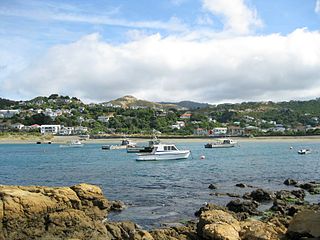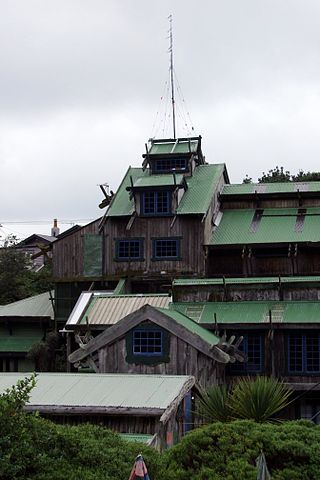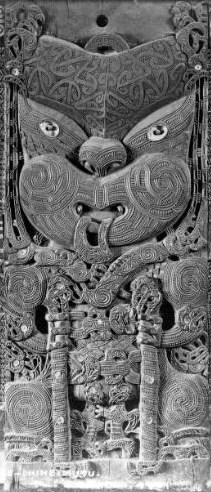
A marae, malaʻe, meʻae or malae is a communal or sacred place that serves religious and social purposes in Polynesian societies. In all these languages, the term also means cleared and free of weeds or trees. Marae generally consist of an area of cleared land roughly rectangular, bordered with stones or wooden posts perhaps with paepae (terraces) which were traditionally used for ceremonial purposes; and in some cases, such as Easter Island, a central stone ahu or a'u is placed. In the Easter Island Rapa Nui culture, the term ahu or a'u has become a synonym for the whole marae complex.

Island Bay is a coastal suburb of Wellington, the capital of New Zealand, situated 5 km (3.1 mi) south of the city centre.

Tapu Te Ranga Marae is located in Island Bay, Wellington, New Zealand. The marae was founded in 1974 by Bruce Stewart, who lived there until his death in 2017. The ten story high structure was built largely by hand from recycled materials over a thirty year period, as a tribute to Stewart's mother, Hinetai Hirini. It was listed as a heritage site, but was destroyed by fire in 2019.
Ngāti Raukawa is a Māori iwi with traditional bases in the Waikato, Taupō and Manawatu/Horowhenua regions of New Zealand. In 2006, 29,418 Māori registered their affiliation with Ngāti Raukawa.

Tikitiki is a small town in Waiapu Valley on the north bank of the Waiapu River in the Gisborne Region of the North Island of New Zealand. The area in which the town resides was formerly known as Kahukura. By road, Tikitiki is 145 km (90 mi) north-northeast of Gisborne, 20 km (12 mi) northeast by north of Ruatoria, and 24 km (15 mi) south by east of Te Araroa. The name of the town comes from the full name of Māui, Māui-tikitiki-a-Taranga. State Highway 35 passes through the town at the easternmost point of the New Zealand state highway network.

Toi whakairo or just whakairo (carving) is a Māori traditional art of carving in wood, stone or bone.
James Moriarty is a New Zealand actor and theatre director, who began acting professionally in 1967. He came to national attention and is probably best known for his role as the school teacher Riki Winiata in the 1970s soap opera Close to Home. His work has toured nationally and internationally. Moriarty is from the Māori tribes of Ngāti Toa, Ngāti Koata and Ngāti Kahungunu.

In Māori tradition of New Zealand, Tama-te-kapua, also spelt Tamatekapua and Tama-te-Kapua and also known as Tama, was the captain of the Arawa canoe which came to New Zealand from Polynesia in about 1350. A trickster, his theft of fruit from the orchard of the chieftain Uenuku escalated into a feud which forced him to leave the ancestral homeland of Hawaiki. On departure, he kidnapped Whakaotirangi, the wife of Ruaeo, and the priest Ngātoro-i-rangi. During the journey he was discovered sleeping with the wife of Ngātoro-i-rangi, who almost destroyed the canoe in revenge. When he arrived in New Zealand, he tricked the crew of the Tainui into believing that he had arrived before them. He staked claims to Mount Moehau in the Coromandel Peninsula and to Maketu in the central Bay of Plenty, where he settled. Shortly after this, he was defeated by the vengeful Ruaeo and feuded with his son Kahumatamomoe, departing to Moehau, where he died.

Sir "Sidney" Hirini Moko Haerewa Mead is a New Zealand anthropologist, historian, artist, teacher, writer and prominent Māori leader. Initially training as a teacher and artist, Mead taught in many schools in the East Coast and Bay of Plenty regions, and later served as principal of several schools. After earning his PhD in 1968, he taught anthropology in several universities abroad. He returned to New Zealand in 1977 and established the first Māori studies department in the country. Mead later became a prominent Māori advocate and leader, acting in negotiations on behalf of several tribes and sitting on numerous advisory boards. He has also written extensively on Māori culture. He is currently the chair of the council of Te Whare Wānanga o Awanuiārangi.
Erenora Puketapu-Hetet was a noted New Zealand weaver and author. A key figure in the Māori cultural renaissance, she helped change perceptions of Māori weaving/raranga from craft to internationally recognised art.
Diggeress Rangituatahi Te Kanawa was a New Zealand Māori tohunga raranga of Ngāti Maniapoto and Ngāti Kinohaku descent. At the time of her death she was regarded as New Zealand's most renowned weaver.
Akuaku, also known as Aku Aku, was a settlement approximately halfway between Waipiro Bay and Whareponga in the East Coast region of New Zealand's North Island. A traditional landing point for waka taua, the town is most notable now as the former home of Major Ropata Wahawaha, N.Z.C, as well as the ancestral home of Te Whānau-a-Rākairoa.

The Māori people and Moriori people have 773 tribal marae around New Zealand. These grounds usually include a wharenui and are usually affiliated with iwi (tribes) and hapū (sub-tribes).
Māori Indians are an ethnic group in New Zealand of people with mixed Māori and Indian ancestry.
Albert Alexander Amahou Belz is a New Zealand actor, writer and lecturer.
Taki Rua is a theatre organisation based in Wellington, New Zealand that has produced many contemporary Māori theatre productions. Taki Rua has been going since 1983 and has had several name changes over that time including The New Depot, Depot Theatre and Taki Rua / The Depot. The full current name is Taki Rua Productions. Since inception the mission of Taki Rua has been to showcase work from New Zealand. Because of this and the longevity of Taki Rua many significant New Zealand actors, directors, writers, designers and producers have part of the history including Riwia Brown, Nathaniel Lees, Rachel House and Taika Waititi.
Diane Prince is a painter, weaver, installation art practitioner and set designer and affiliates to the Maori iwi Ngā Puhi and Ngāti Whātua from the north of New Zealand.
Helen Pearse-Otene is a New Zealand playwright, actor and author.

Barbara Jean Mitcalfe née Fougère was a New Zealand conservationist, botanist and educator. She is best known for being an expert field botanist, for her conservation work in and around the Wellington region, and for helping to establish the first Māori preschool.










